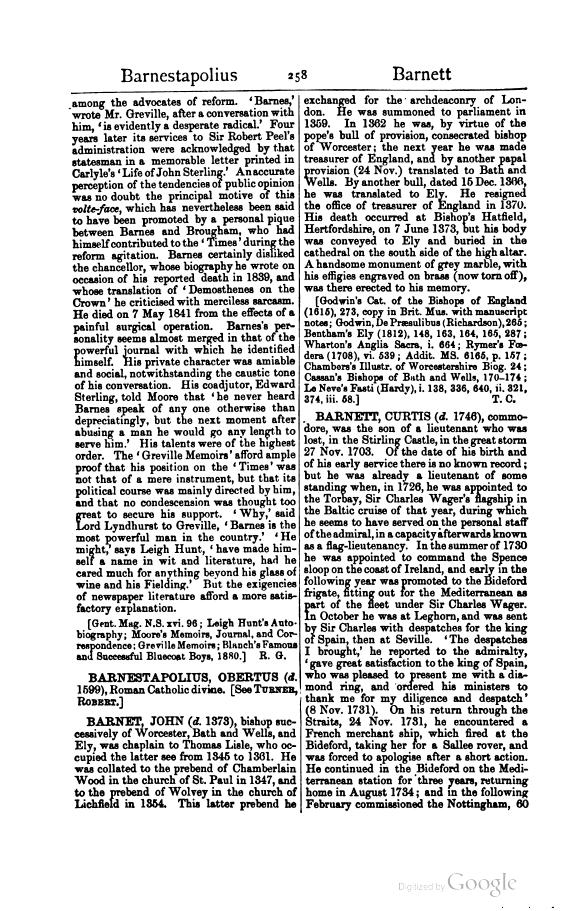among the advocates of reform. ‘Barnes,’ wrote Mr. Greville, after a conversation with him, ‘is evidently a desperate radical.’ Four years later its services to Sir Robert Peel's administration were acknowledged by that statesman in a memorable letter printed in Carlyle's ‘Life of John Sterling.’ An accurate perception of the tendencies of public opinion was no doubt the principal motive of this volte-face, which has nevertheless been said to have been promoted by a personal pique between Barnes and Brougham, who had himself contributed to the ‘Times’ during the reform agitation. Barnes certainly disliked the chancellor, whose biography he wrote on occasion of his reported death in 1839, and whose translation of ‘Demosthenes on the Crown’ he suffered Dean Blakesley to criticise with merciless sarcasm. He died on 7 May 1841 after a surgical operation. Barnes's personality seems almost merged in that of the powerful journal with which he identified himself. His private character was amiable and social, notwithstanding the caustic tone of his conversation. His coadjutor, Edward Sterling, told Moore that ‘he never heard Barnes speak of any one otherwise than depreciatingly, but the next moment after abusing a man he would go any length to serve him.’ His talents were of the highest order. The ‘Greville Memoirs’ afford ample proof that his position on the ‘Times’ was not that of a mere instrument, but that its political course was mainly directed by him, and that no condescension was thought too great to secure his support. ‘Why,’ said Lord Lyndhurst to Greville, ‘Barnes is the most powerful man in the country.’ ‘He might,’ says Leigh Hunt, ‘have made himself a name in wit and literature, had he cared much for anything beyond his glass of wine and his Fielding.’ But the exigencies of newspaper literature afford a more satisfactory explanation.
[Gent. Mag. N.S. xvi. 96; Leigh Hunt's Autobiography; Moore's Memoirs, Journal, and Correspondence; Greville Memoirs; Blanch's Famous and Successful Bluecoat Boys, 1880.]
BARNESTAPOLIUS, OBERTUS (d. 1699), Roman Catholic divine [See Turner, Robert.]
BARNET, JOHN (d. 1373), bishop successively of Worcester, Bath and Wells, and Ely, was chaplain to Thomas Lisle, who occupied the latter see from 1345 to 1361. He was collated to the prebend of Chamberlain Wood in the church of St. Paul in 1347, and to the prebend of Wolvey in the church of Lichfield in 1354. This latter prebend he exchanged for the archdeaconry of London. He was summoned to parliament in 1359. In 1362 he was, by virtue of the pope's bull of provision, consecrated bishop of Worcester; the next year he was made treasurer of England, and by another papal provision (24 Nov.) translated to Bath and Wells. By another bull, dated 15 Dec. 1366, he was translated to Ely. He resigned the office of treasurer of England in 1370. His death occurred at Bishop's Hatfield, Hertfordshire, on 7 June 1373, but his body was conveyed to Ely and buried in the cathedral on the south side of the high altar. A handsome monument of grey marble, with his effigies engraved on brass (now torn off), was there erected to his memory.
[Godwin's Cat. of the Bishops of England (1615), 273, copy in Brit. Mus. with manuscript notes; Godwin, De Præsulibus (Richardson), 265; Bentham's Ely (1812), 148, 163, 164, 165, 287; Wharton's Anglia Sacra, i. 664; Rymer's Fœdera (1708), vi. 539; Addit. MS. 6165, p. 157; Chambers's Illustr. of Worcestershire Biog. 24; Cassan's Bishops of Bath and Wells, 170–174; Le Neve's Fasti (Hardy), i. 138, 336, 640, ii. 321, 374, iii. 58.]
BARNETT, CURTIS (d. 1746), commodore, was the son of a lieutenant who was lost, in the Stirling Castle, in the great storm 27 Nov. 1703. Of the date of his birth and of his early service there is no known record; but he was already a lieutenant of some standing when, in 1726, he was appointed to the Torbay, Sir Charles Wager's flagship in the Baltic cruise of that year, during which he seems to have served on the personal staff of the admiral, in a capacity afterwards known as a flag-lieutenancy. In the summer of 1730 he was appointed to command the Spence sloop on the coast of Ireland, and early in the following year was promoted to the Bideford frigate, fitting out for the Mediterranean as part of the fleet under Sir Charles Wager. In October he was at Leghorn, and was sent by Sir Charles with despatches for the king of Spain, then at Seville. ‘The despatches I brought,’ he reported to the admiralty, ‘gave great satisfaction to the king of Spain, who was pleased to present me with a diamond ring, and ordered his ministers to thank me for my diligence and despatch’ (8 Nov. 1731). On his return through the Straits, 24 Nov. 1731, he encountered a French merchant ship, which fired at the Bideford, taking her for a Sallee rover, and was forced to apologise after a short action. He continued in the Bideford on the Mediterranean station for three years, returning home in August 1734; and in the following February commissioned the Nottingham, 60
